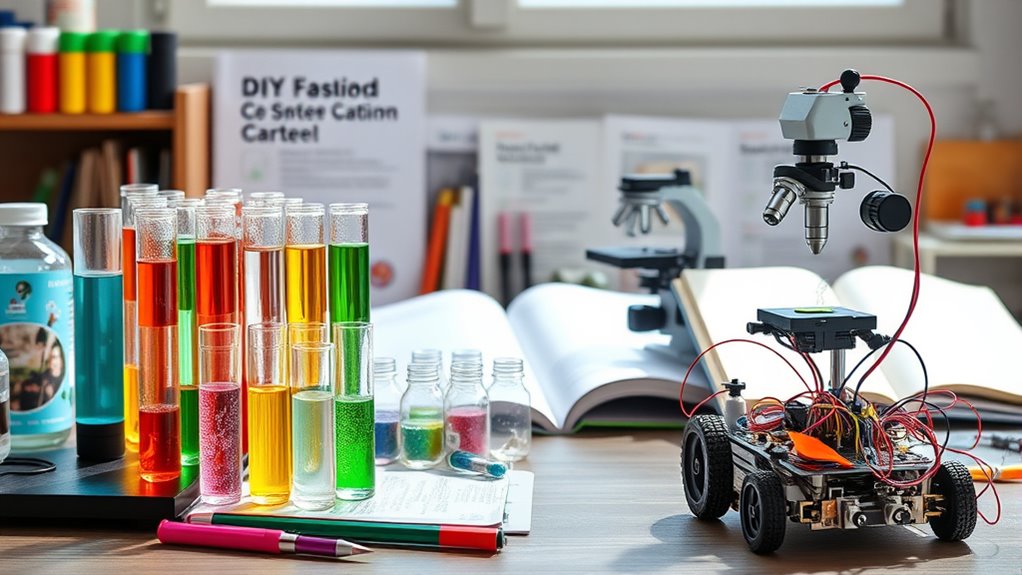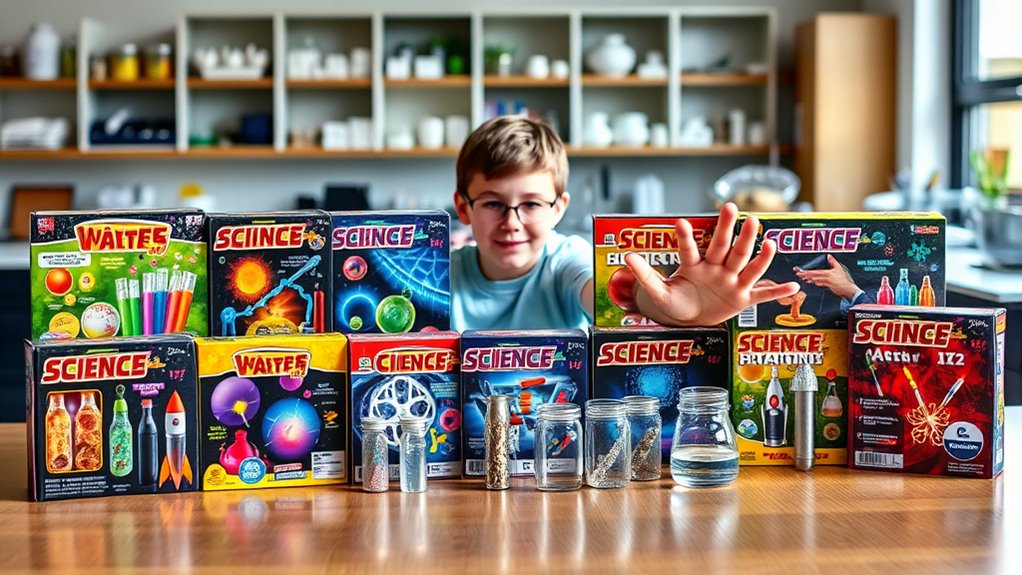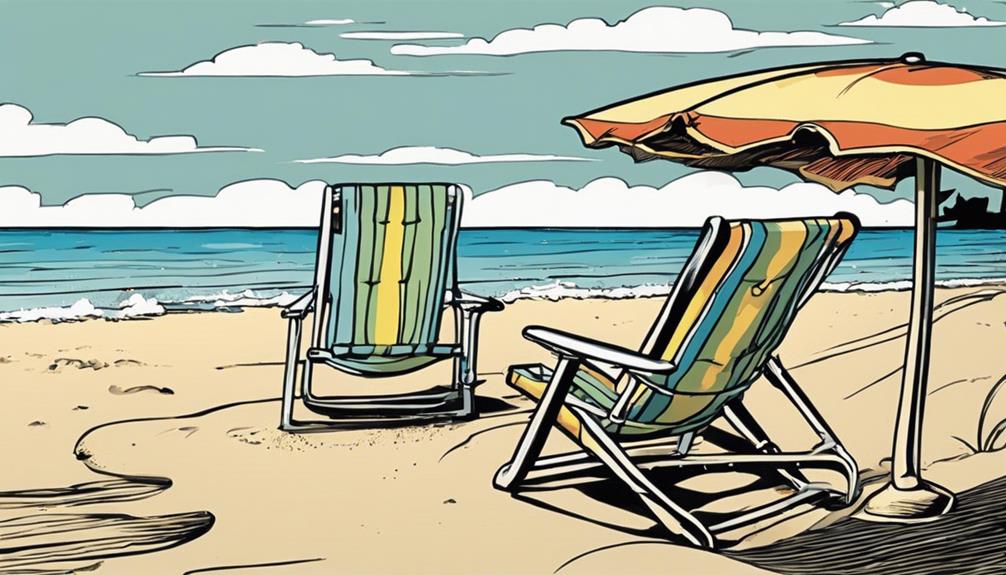If you’re looking for the best science kits for teenagers that spark curiosity and foster learning, I’ve got you covered. From hands-on experiments in chemistry, physics, and engineering to robotics and environmental science, these kits offer engaging activities that make STEM fun and accessible. Many include real tools, detailed guides, and even specimens to enhance the experience. Keep exploring, and you’ll find options to inspire the scientist in every teen.
Key Takeaways
- A diverse selection of science kits covers disciplines like chemistry, physics, earth science, and engineering to spark teenage curiosity.
- Many kits include detailed instructions, real scientific tools, and engaging experiments to enhance hands-on learning.
- Suitable for various age groups, with some requiring supervision, fostering safe exploration and skill development.
- Popular options feature interactive components such as app guides, real specimens, and advanced assembly projects.
- These kits promote critical thinking, STEM skills, creativity, and a love for science through fun, educational activities.
UNGLINGA 150 Experiments Science Kits for Kids
If you’re looking for a science kit that truly engages kids with hands-on experiments, the UNGLINGA 150 Experiments Science Kit is an excellent choice. It offers a wide variety of 150 DIY projects covering earth sciences, chemistry, physics, and more, sparking curiosity and exploration. The kit includes easy-to-follow, well-illustrated instructions and high-quality tools, making experiments safe and accessible using household items. Kids can act like real scientists with goggles and hands-on activities, turning learning into fun. Perfect for birthdays, holidays, or summer activities, it fosters curiosity, problem-solving skills, and a love for science from an early age.
Best For: parents, teachers, and kids who want a comprehensive, safe, and engaging science learning experience through hands-on experiments at home or in the classroom.
Pros:
- Offers 150 diverse DIY experiments across multiple scientific disciplines, encouraging broad exploration.
- Comes with clear, illustrated instructions and high-quality, kid-friendly tools for safe and confident experimentation.
- Promotes active learning, problem-solving, and curiosity while making science fun and accessible for children of various ages.
Cons:
- The large number of experiments may be overwhelming for some users to try all at once.
- Some experiments might require household items that are not included, potentially needing additional shopping.
- The extensive kit could be more expensive compared to smaller or simpler science sets.
4M Clean Water Science STEM Toy for Kids & Teens
The M Clean Water Science STEM Toy for Kids & Teens stands out as an excellent choice for young science enthusiasts enthusiastic to explore environmental science and water purification. This kit offers hands-on experiments like building filtration systems, desalination devices, and disinfecting water with solar power. It includes components such as filters, active carbon, sand, gravel, and detailed instructions, making assembly straightforward. The activities teach core concepts like water treatment, salt removal, and environmental awareness. Compact and lightweight, it’s perfect for classroom or home use. Many users praise its educational value and engaging experiments, though some minor modifications may be needed for ideal performance.
Best For: young science enthusiasts aged 8 and up interested in exploring environmental science, water purification, and STEM concepts through hands-on experiments.
Pros:
- Engages children with fun, educational activities demonstrating water filtration and desalination
- Includes comprehensive components and detailed instructions for easy assembly and learning
- Promotes environmental awareness and STEM skills in a portable, lightweight design
Cons:
- Some parts may require modification, such as sanding the bottle cap adapter, for optimal fit
- Small components and complex instructions might be challenging for younger children without supervision
- Using small water quantities (around 20-50 ml) is recommended for clearer demonstrations
Playz Mega Kaboom! Science Experiments Kit for Kids
is an exciting science kit packed with over 150 explosive experiments designed for kids aged 8-12. I love how it combines fun with education, offering activities like balloon rockets, fizzy bombs, and color explosions. The included app and video guides make it easy for children to follow step-by-step instructions and learn scientific concepts hands-on. While some users find the kit’s size modest and chemical supplies limited, it’s perfect for sparking curiosity and developing scientific thinking. Overall, Playz Mega Kaboom! makes a fantastic gift that keeps kids engaged and enthusiastic to explore chemistry and physics safely.
Best For: kids aged 8-12 who are interested in hands-on science experiments that combine fun with educational learning.
Pros:
- Offers over 150 engaging experiments with app and video guidance for interactive learning
- Encourages curiosity in chemistry, physics, and scientific principles in a safe, playful environment
- Suitable as a gift for multiple children, providing hours of educational entertainment
Cons:
- Limited chemicals and materials may require additional purchases for more advanced experiments
- The kit’s size and content are modest compared to expectations of a “mega” scale
- Some instructions and explanations may be inconsistent or simplified for younger users
Thames & Kosmos Mega Cyborg Hand STEM Kit
Looking for a science kit that combines hands-on engineering with real-world applications? The Thames & Kosmos Mega Cyborg Hand STEM Kit is perfect for that. It lets you build a giant hydraulic hand operated by your fingers, no motors or batteries needed. Filled with over 200 parts, the kit uses water-filled pistons to mimic human hand movements, allowing you to grip and lift small objects. The adjustable design fits different hand sizes and can be configured as a right hand, left hand, or claw. It’s an engaging way to explore hydraulics, pneumatics, and robotics, offering a realistic, interactive experience that sparks curiosity and builds mechanical skills.
Best For: STEM enthusiasts, young robotics learners, and educators seeking an engaging hands-on engineering project.
Pros:
- Encourages understanding of hydraulics, pneumatics, and robotics through practical building experience
- High-quality, durable plastic parts with clear, detailed instructions suitable for various skill levels
- Award-winning educational toy that promotes patience, focus, and mechanical skills in a fun, interactive way
Cons:
- Assembly can be time-consuming and may require adult supervision, especially for younger children
- Packaging issues such as dents or damaged seals can affect the presentation or completeness of the kit
- The complexity may be challenging for very young children, making it more suitable for ages 10 and up
NATIONAL GEOGRAPHIC Science Magic Kit with Experiments and Tricks
If you’re searching for a science kit that sparks curiosity through hands-on magic and chemistry experiments, the NATIONAL GEOGRAPHIC Science Magic Kit is an excellent choice. It offers over 100 unique experiments, combining science with magic tricks like bending metal with water, floating coins, and creating snow in your hand. The kit includes a chemistry set, accessories, and a bonus guide with more than 85 household experiments, encouraging further exploration. Developed by Blue Marble, a reputable company, it promotes education, creativity, and fun. This interactive kit is perfect for teens who want to learn science while performing impressive tricks that amaze friends and family.
Best For: kids and teens interested in learning science through fun, hands-on magic tricks and experiments that combine education with entertainment.
Pros:
- Over 100 unique experiments and 20 magic tricks that engage children actively in science learning
- Includes a variety of accessories like a magic wand and gloves to enhance performance and presentation
- Bonus guide with more than 85 household experiments encourages ongoing exploration and creativity
Cons:
- Some experiments may require adult supervision or assistance for younger children
- The kit might be more suitable for older kids due to the complexity of some tricks and experiments
- Limited information on the durability of included accessories for repeated use
National Geographic Chemistry Set with 45 Experiments for Kids
The National Geographic Chemistry Set with 45 experiments is an excellent choice for curious kids aged 8 and up who want hands-on STEM learning. I love how it offers a variety of activities like crystal growing, chemical reactions, glow-in-the-dark solutions, and homemade bouncy balls. The kit includes real scientific tools such as test tubes, beakers, and pipettes, making experiments feel authentic. With step-by-step illustrated instructions, children can confidently explore science independently or with minimal help. Rated 4.7 stars, this set keeps kids engaged, sparks curiosity, and makes learning fun. It’s a fantastic gift for young science enthusiasts enthusiastic to discover chemistry firsthand.
Best For: curious kids aged 8 and up who want engaging, hands-on STEM learning with safe, authentic science experiments.
Pros:
- Offers 45 diverse experiments that promote educational fun and curiosity
- Includes real scientific tools like test tubes, beakers, and pipettes for an authentic experience
- Illustrated, step-by-step instructions make it easy for children to explore independently
Cons:
- Some experiments may be time-consuming or messy, requiring protective coverings
- A few reviews mention missing ingredients or experiments not working as expected
- The kit is designed for ages 8+, so younger children may need supervision or assistance
4M Crystal Growing Science Kit with Display Cases
For young science enthusiasts enthusiastic to explore geology and crystal growth, the M Crystal Growing Science Kit with Display Cases offers an engaging hands-on experience. It includes materials for seven crystal growth experiments, using hot water (distilled recommended) and complete instructions. Designed to promote STEM learning, it challenges kids aged 10 and up to imagine and experiment. The kit features a special display case, allowing kids to admire and showcase their fully grown crystals, making it perfect for collection and visual appreciation. As part of the 4M STEM toy line, it’s an excellent educational gift that sparks curiosity and encourages exploration in young minds.
Best For: young science enthusiasts aged 10 and up who are interested in geology, crystal growth, and STEM learning through engaging, hands-on experiments.
Pros:
- Provides materials for seven different crystal growth experiments, offering extensive hands-on learning.
- Includes a display case to showcase and admire the fully grown crystals, enhancing visual appeal.
- Encourages curiosity and imagination while promoting STEM education in a fun, interactive way.
Cons:
- Requires hot water (preferably distilled), which may not be readily available for all users.
- Suitable only for children aged 10 and above, limiting accessibility for younger kids.
- May require adult supervision for safety and proper handling of materials during experiments.
National Geographic Mega Science Lab for Kids
Designed for curious young explorers, the National Geographic Mega Science Lab stands out as an excellent choice for kids aged 8 and up who want a thorough and engaging science experience. This award-winning kit includes over 130 experiments across Earth science, chemistry, and STEM magic projects. Kids can build erupting volcanoes, grow glow-in-the-dark crystals, and dig up real fossils, all with safety gear included. The detailed instructions make complex concepts accessible, fostering critical thinking. With real rock and mineral specimens, it sparks curiosity about geology and chemistry. Parents praise its high quality and educational value, making it a fantastic gift for inspiring a lifelong love of science.
Best For: young science enthusiasts aged 8 and up who are eager to explore Earth science, chemistry, and magic STEM projects through hands-on experiments.
Pros:
- Offers over 130 engaging and diverse experiments that foster curiosity and learning.
- Includes real rock, mineral, and crystal specimens, enhancing geology and chemistry exploration.
- Comes with safety gear such as goggles and gloves, ensuring safe and responsible scientific play.
Cons:
- The size and weight (approximately 16.61 x 12.52 x 4.25 inches and 5.81 pounds) may be less convenient for storage or portability.
- Some experiments may require parental assistance, which could be a consideration for independent young scientists.
- The kit’s complexity might be challenging for children at the lower end of the recommended age group without guidance.
Thames & Kosmos Chemistry Chem C500 Science Kit
If you’re looking to introduce teenagers to chemistry with a hands-on, educational experience, the Thames & Kosmos Chemistry Chem C500 Science Kit stands out as a great choice. It includes 28 experiments, a colorful manual, and real lab materials like glass beakers and chemicals. Designed for ages 10-15, it covers acid-base reactions, fizzing, foaming, and invisible ink, making chemistry fun and engaging. The kit teaches basic concepts like chemical reactions, safety, and scientific thinking. Many users find it educational and entertaining, perfect for sparking curiosity. Just remember, adult supervision and some extra supplies are recommended for a safe, successful experience.
Best For: parents, teachers, and teenagers aged 10-15 seeking a hands-on, educational introduction to chemistry through safe, engaging experiments.
Pros:
- Includes real lab materials like glass beakers and chemicals for authentic experiments
- Covers fundamental concepts such as acid-base reactions, gas formation, and physical changes
- Encourages curiosity, scientific thinking, and family bonding through fun activities
Cons:
- Small quantities of chemicals may require additional purchases of supplies like batteries and distilled water
- Some parts or chemicals may be loose or contaminated if not handled carefully during packaging or use
- Requires adult supervision for safe handling of chemicals and glassware
UNGLINGA 70 Lab Experiments Science Kits for Kids
The UNGLINGA 70 Lab Experiments Science Kits for Kids stands out as an excellent choice for young aspiring scientists enthusiastic to explore chemistry and physics through hands-on activities. With 70 experiments like erupting volcanoes, crystal growing, balloon rockets, and fruit circuits, it offers engaging, easy-to-follow projects that make learning fun. The kit promotes critical thinking, problem-solving, and a solid understanding of scientific principles, chemistry fundamentals, and safe experiment conduct. Clear instructions and illustrated guides help kids grasp complex concepts, while high-quality, child-safe materials make certain a secure, durable experience. It’s a perfect gift to inspire curiosity, social sharing, and a lasting love for science.
Best For: young children and beginners eager to explore science through safe, engaging, and educational experiments that foster critical thinking and STEM skills.
Pros:
- Offers 70 diverse experiments including volcanoes, crystal growing, and balloon rockets for comprehensive learning.
- Comes with clear, illustrated instructions and educational guides to simplify complex scientific concepts.
- Made with high-quality, child-safe materials ensuring safety, durability, and a positive learning experience.
Cons:
- The extensive number of experiments may require a significant time commitment to complete all activities.
- Some users might find the need for additional supervision depending on the child’s age and experience.
- The kit may not include all necessary household items, requiring extra supplies for certain experiments.
“Hydrobot Arm Kit”, Hydraulic Kit, STEM Building Toy for Kids 12+
For teens interested in hands-on engineering and robotics, the Hydrobot Arm Kit offers an engaging introduction to hydraulic systems without relying on batteries or motors. This STEM building toy teaches mechanical, hydraulic, and robotics principles through detailed assembly. The multi-axis arm can rotate up to 270°, with precise movements like wrist rotation and vertical reach. Powered solely by water hydraulics, it encourages problem-solving and curiosity. Although assembly takes time and may require adult help, the realistic hydraulics and durable parts make it a rewarding project. Overall, it’s a fantastic way for teens to explore engineering concepts while having fun building a functional, hydraulic robotic arm.
Best For: teens and older kids interested in hands-on engineering, robotics, and hydraulic systems who enjoy building educational and functional STEM projects.
Pros:
- Teaches mechanical engineering, hydraulics, and robotics through engaging, hands-on assembly.
- Powered solely by water hydraulics, eliminating the need for batteries or motors, promoting green energy concepts.
- Durable parts and realistic hydraulics provide a rewarding, educational experience with clear instructions.
Cons:
- Assembly can be time-consuming and may require adult supervision and patience.
- Hydraulic tubing may relax or pop off over time, necessitating re-bleeding or reinforcement.
- Packaging quality has room for improvement, and some parts may loosen with frequent use.
National Geographic Kids Junior Chemistry Set
Designed specifically for young children aged 4 and up, the National Geographic Kids Junior Chemistry Set offers a hands-on, engaging way to introduce early science concepts. With 50 experiments and over 20 kid-friendly tools, it makes learning chemistry fun and accessible. The kit uses household items like baking soda and vinegar, encouraging kids to explore cause-and-effect relationships. Clear, illustrated instructions help children perform experiments independently, fostering curiosity and critical thinking. Durable, safe tools ensure a realistic science experience. Parents and educators love how it keeps kids entertained while developing early STEM skills, making it a perfect starter kit for young science enthusiasts.
Best For: young children aged 4 and up who are curious about science and eager to explore basic chemistry concepts through fun, hands-on experiments.
Pros:
- Includes 50 engaging experiments that promote early STEM learning
- Kid-friendly tools and clear instructions ensure safe and independent experimentation
- Encourages curiosity, critical thinking, and creativity in young learners
Cons:
- Limited to household items like baking soda and vinegar, which may restrict some experiment variety
- May require adult supervision for the youngest children to ensure safety
- The kit’s focus on basic chemistry might be less suitable for children seeking more advanced science activities
ELEGOO UNO R3 Robot Car Kit for Arduino STEM Science Kits for Kids
If you’re looking to spark a teenager’s interest in robotics and electronics, the ELEGOO UNO R3 Robot Car Kit stands out as an excellent choice. Designed for ages 8-16, it promotes STEM learning through hands-on assembly, programming, and engineering. The kit includes 24 modules like obstacle avoidance and line tracing, all controllable via phone or tablet, making it highly interactive. Its easy-to-assemble design with clear, step-by-step instructions helps beginners get started quickly. The sleek packaging makes it a great gift, and it’s perfect for developing creativity, problem-solving, and technical skills in young learners.
Best For: young learners aged 8-16 interested in developing robotics, electronics, and programming skills through hands-on STEM activities.
Pros:
- Easy-to-assemble with clear, step-by-step instructions suitable for beginners
- Includes 24 modules like obstacle avoidance and line tracing for versatile learning experiences
- Compatible with Android and iOS devices for remote control and interactive play
Cons:
- Basic electronic knowledge recommended; supervision advised for younger children or complete beginners
- May require additional tools or components for full assembly and experimentation
- Limited advanced programming features, making it more suitable for beginners than experienced hobbyists
STEM Bluetooth Speaker Building Kit for Kids & Adults
The STEM Bluetooth Speaker Building Kit stands out as an excellent choice for beginners and hobbyists enthusiastic to explore electronics without the need for soldering or advanced skills. I love how it offers a hands-on way to understand how speakers work by assembling your own device. The kit uses high-quality, safe components like circuit boards, battery boxes, and wooden parts, all checked for safety and reliability. Its clear instructions make assembly straightforward and fun, perfect for all ages. Plus, it’s a stylish, practical gift for any occasion and a great activity for families or classrooms to encourage teamwork and curiosity in science and engineering.
Best For: beginners, hobbyists, and families seeking a safe, educational, and hands-on STEM activity to build and understand Bluetooth speakers without soldering.
Pros:
- No soldering required, making it accessible for all skill levels
- High-quality, safety-checked components ensure reliability and safety
- Engaging and educational, perfect for family bonding or classroom learning
Cons:
- Limited advanced electronics features for experienced tech enthusiasts
- May require adult supervision for younger children during assembly
- The kit’s design is focused on basic speaker construction, limiting customization options
4M Kidzlabs Magnetic Levitation Science Kit
The M Kidzlabs Magnetic Levitation Science Kit stands out as a perfect choice for young science enthusiasts aged 8 and up who want hands-on experience with magnetic forces. This kit offers engaging experiments like floating a pencil, levitating screws, building a maglev, and creating a robotic magnet. It includes high-quality magnets, durable plastic parts, and detailed instructions to guide kids through each project. Designed to inspire curiosity, it encourages experimentation with magnetic attraction and repulsion. While some assembly may need adult help, the kit provides numerous opportunities for repeated learning and creativity. It’s an excellent way for kids to explore the fascinating world of magnetic levitation.
Best For: young science enthusiasts aged 8 and above who are interested in exploring magnetic forces through hands-on experiments and creative projects.
Pros:
- Includes high-quality magnets and durable plastic parts for repeated use
- Offers engaging, educational experiments that demonstrate magnetic attraction and repulsion
- Encourages creativity and curiosity by allowing children to build maglevs and robotic models
Cons:
- Some assembly may require adult assistance, especially for younger children
- Magnets and small plastic parts can be fragile or may not fit perfectly
- Instructions may have tiny print, making guidance challenging for some users
Factors to Consider When Choosing Science Kits for Teenagers

When choosing science kits for teenagers, I believe it’s crucial to take into account their age and skill level to guarantee the activities are suitable and engaging. Safety precautions are also a must, especially for more complex experiments. Finally, I focus on the educational value and experiment complexity to make sure the kit truly sparks curiosity and learning.
Age-Appropriate Content
Choosing a science kit that matches a teenager’s developmental level is essential for keeping them engaged and challenged. It’s important to pick kits with content and experiments suited for their cognitive skills, such as complex chemical reactions or engineering projects. This guarantees they stay interested and learn effectively. Make sure the kit includes clear, age-appropriate safety instructions and materials, so they can perform experiments independently or with minimal supervision. Look for kits that introduce advanced scientific concepts or real-world applications, aligning with their growing curiosity and knowledge. Avoid overly simplistic activities designed for younger children, as these may fail to captivate a teenager or push their understanding further. Selecting the right content keeps their enthusiasm high and promotes meaningful learning experiences.
Safety Precautions Needed
Ensuring safety should be a top priority when selecting science kits for teenagers, as proper precautions help prevent accidents and promote confident experimentation. First, check that the kit includes essential safety gear like goggles, gloves, and aprons to protect against spills and splashes. Verify all chemicals and materials are labeled as non-toxic and safe for indoor use, reducing health hazards. It’s also important that the kit provides clear safety instructions and emergency procedures, so teens know how to handle accidents or spills confidently. Confirm the experiments are suitable for their age, avoiding activities that require advanced skills or pose high risks. Finally, look for certifications like ASTM or CE markings, which indicate the kit meets established safety standards and regulations.
Skill Level Match
Selecting a science kit that matches a teenager’s skill level helps keep them engaged and confident in their experiments. It’s important to check that the age recommendation aligns with their developmental stage, ensuring the activities are both safe and appropriate. Consider whether the kit offers more advanced experiments that challenge their existing knowledge and encourage critical thinking. Look for kits that include complex concepts and activities requiring problem-solving, which can deepen their understanding of science. Also, verify if the instructions are clear enough for teens to work independently or with minimal supervision. Finally, choose kits that allow for customization or extension activities, so they can grow their skills as their interest and confidence in science increase over time.
Experiment Complexity
When evaluating science kits for teenagers, it’s essential to take into account the complexity of the experiments included, as this directly impacts their engagement and learning. The right level of challenge ensures teens stay motivated without feeling overwhelmed. Advanced kits often feature multi-step procedures that require prior knowledge of scientific concepts, which can deepen understanding but may be intimidating for beginners. Simpler experiments focus on core principles, making them ideal for those just starting out. When choosing, consider the number of steps, tools needed, and instruction detail to gauge if the intricacy matches the teen’s skills. Kits with electronics, coding, or mechanical components tend to be more intricate, fostering a more thorough grasp of science. Balancing challenge and accessibility is key to a successful learning experience.
Educational Value Focus
Evaluating the educational value of science kits means looking closely at how well they cover a range of scientific concepts and skills. I focus on whether the kit explores chemistry, physics, biology, or engineering principles in depth, ensuring it offers more than just fun. A strong kit includes thorough manuals that clearly explain scientific theories and processes, helping teens understand the “why” behind each experiment. The presence of real scientific tools, authentic specimens, or advanced experiments enhances hands-on learning and reinforces concepts. I also consider if the kit encourages critical thinking, problem-solving, and inquiry, prompting teens to hypothesize, experiment, and analyze results. In conclusion, I check if the kit aligns with educational standards or STEM curricula, supporting structured learning while fostering curiosity and long-term interest in science.
Material Quality Standards
Ensuring that a science kit is made from high-quality materials is vital for safety and durability. When I choose a kit, I look for items that meet recognized safety certifications like ASTM, CE, or ISO, which confirm they adhere to strict safety standards. High-quality plastics, corrosion-resistant metals, and reliable electronic components not only extend the kit’s lifespan but also guarantee safer experiments. Premium materials help prevent breakage, contamination, or malfunction, reducing potential hazards during use. I also consider whether the manufacturer follows strict manufacturing procedures, which minimizes the risk of hazardous substances being included. Overall, material quality standards are essential to guarantee that the kit is safe, long-lasting, and suitable for teenage learners, providing peace of mind during hands-on science exploration.
Engagement and Fun
Choosing a science kit that keeps teenagers engaged and having fun is essential for fostering their curiosity. I look for kits with a variety of experiments that are visually stimulating and interactive, which helps maintain their interest. Hands-on activities that show immediate results or visible reactions make learning exciting and help sustain their curiosity. Including experiments related to current scientific trends or real-world applications can boost relevance and motivation. Kits with step-by-step instructions, especially those offering digital or multimedia guidance, appeal to tech-savvy teens. Additionally, options that encourage creative exploration and customization invite teens to experiment beyond basic instructions. This freedom to innovate increases both engagement and enjoyment, making science feel like an adventure rather than a chore.
Frequently Asked Questions
How Do Science Kits Enhance Critical Thinking Skills in Teenagers?
Science kits boost my critical thinking by encouraging me to analyze experiments and troubleshoot issues. As I follow step-by-step instructions, I learn to evaluate results, make predictions, and adjust my approach. This hands-on process sharpens my problem-solving skills and deepens my understanding of scientific concepts. Engaging with these kits pushes me to think independently, question outcomes, and develop a curious mindset that’s essential for learning.
Are There Science Kits Suitable for Advanced Teenage Learners?
Absolutely, there are science kits perfect for advanced teenage learners. These kits challenge curious minds, combining complex experiments with in-depth concepts, unlike beginner sets. They cover areas like robotics, chemistry, and physics, pushing teens to think critically and problem-solve. I recommend exploring kits from brands like Thames & Kosmos or National Geographic, which offer advanced projects that inspire mastery and ignite a passion for science.
What Safety Precautions Should Teens Follow During Experiments?
You should always read and follow the instructions carefully, wear safety goggles, and gloves to protect your eyes and skin. Work in a well-ventilated area, keep a fire extinguisher nearby, and avoid eating or drinking during experiments. Never mix chemicals without knowing their reactions, and ask an adult for help if you’re unsure about anything. Safety comes first to make sure your experiments are fun and safe.
Can Science Kits Be Integrated Into School Curricula Effectively?
Absolutely, science kits can be seamlessly integrated into school curricula. I imagine students as explorers, their curiosity ignited like fireflies in a jar, discovering concepts firsthand. When teachers incorporate these kits into lessons, it’s like turning the classroom into a laboratory of discovery. Hands-on experiments make abstract ideas tangible, fostering engagement and deeper understanding. This approach transforms learning into an exciting adventure, inspiring future scientists and innovators.
How Do Science Kits Foster Interest in STEM Careers?
Science kits spark my interest in STEM careers by making complex concepts hands-on and fun. When I experiment with real tools and materials, I see how science applies to everyday life, which fuels my curiosity and confidence. These kits often showcase exciting projects, inspiring me to explore further and consider careers in engineering, biology, or tech. They make STEM feel accessible, engaging, and incredibly rewarding.
Conclusion
Choosing the right science kit is like planting a seed—it sparks curiosity and blooms into a love for discovery. Whether your teen is drawn to experiments, robotics, or magic tricks, these kits provide a fertile ground for exploration. With the right tools in hand, they’ll navigate the world of science like a captain steering through uncharted waters, turning every experiment into a new adventure and fueling their passion for learning.

























